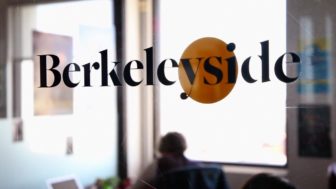

How a News Outlet Raised $600K with a DPO
Read this article in
Русская версия здесь. Russian version is here.
Berkeleyside, the eight-year-old for-profit “local newspaper without the paper,” has raised nearly $600,000 in capital from Californians via an instrument known as a “direct public offering,” or DPO.
 But what, pray tell, is a DPO? A DPO provides a way for the community to invest in a business — whether it’s pickle makers, bakery, a football team, or in this case, a news organization — and for that business to raise capital.
But what, pray tell, is a DPO? A DPO provides a way for the community to invest in a business — whether it’s pickle makers, bakery, a football team, or in this case, a news organization — and for that business to raise capital.
Unlike a crowdfunding campaign like Kickstarter or Indiegogo, people who send money don’t get a promised gift or discount, but rather, they own an actual stake in the business. DPOs come in many flavors but share the feature of flexibility in both the type of security offered and the type of returns offered to investors. For news organizations they can offer a way to become less dependent on the foundation fundraising model and deepen ties within their communities.
(Nonprofits can do DPOs too.) Of course DPOs may not be for every organization — for one thing, you need a community of investors able and willing to part with cash. But minimum investments need not be set at high dollar amounts.
Berkeleyside has raised nearly $600,000 for its DPO, and in late September, the Lenfest Institute for Journalism announced that Berkeleyside would be the recipient of a grant to reach its goal of $800,000, as well as expand its membership program and build a toolkit helping other organizations share what it has learned.
In the interview below — which has been edited for clarity and length — Berkeleyside co-founder Lance Knobel gives his thoughts on “how tos.”
How did you choose to do a direct public offering (DPO) to raise money for Berkeleyside?
Like many new and growing businesses, we had a need for capital. We looked at raising money from individual investors, from wealthy individuals, and talked to a number of people. Some people were interested, but news organizations are not the types of businesses where somebody’s going to get a fantastic return, if they get any return. So, raising hundreds of thousands of dollars from rich individuals would be a rough road, because they will find other things to do with their investment that will have higher returns than a local business.
 When we were in the midst of this investigation, one of our readers got in touch with us, completely out of the blue, and said,
When we were in the midst of this investigation, one of our readers got in touch with us, completely out of the blue, and said,
“Hey, I love you guys, I’m not sure if you need capital, but if you do, I think you’d be a great candidate for a DPO.”
We had no idea what a DPO was…but, we looked into it. All of us instantly reacted that this is exactly what we should do as Berkeleyside. We exist to provide news to our city and our community, but we also exist because of our city and community. That relationship is deep and organic. So raising money from our readers, from our community seemed like a complete no-brainer to us. It was a natural fit.
How is a DPO different from simply asking people to give money, to become members?
Almost from the very start at Berkeleyside, we have asked readers for money through a a membership program, asking them to give $5, $10, $25 a month. It was on the back of one of those email campaigns that we learned from a member about DPOs.
But capital is something different than membership. Having capital to invest in the business provides a cushion of money so that we could respond to things in an opportunistic way. From the start of Berkeleyside we’d lived month-to-month to some extent. We believed we had the relationship with our readers where many readers would say, “Yes, I certainly want to be part of Berkeleyside as an investor, not just as a reader, to have that deeper relationship, a stake in the future.”
If I were to invest in Berkeleyside, what would I get?
You have preferred shares, you are an investor, it’s not just a warm feeling in your heart. When we get to a point where the business is sustainable — the plan is two years — you’ll get an annual three percent dividend. We’re communicating with our investors, we’re updating them regularly as a business, sharing what we’re investing in. They receive various perks and we will hold an annual investors party.
What filings are required, if any?
Nothing needs to be filed with the Securities and Exchange Commission. The California Department of Business Oversight approved our application. It’s a regulated offering. We are not required to do any particular reporting, but we are going to provide a report on our accounts annually, and communicate with investors quarterly, which we do through email.
One of the advantages of doing the DPO in California is we could design it any way we wanted. We could have offered a higher dividend. We could have offered no dividend. We could have said, we’ll think about a dividend. It’s a “design your own offering,” not, “you have to do these six things.”
Every state is different. We considered offering a DPO beyond California, but in the end we didn’t explore that. For a local news organization, restricting investors to our own state was absolutely fine.
Did you get legal advice?
We worked with an Oakland based law firm, Cutting Edge Capital, who specialize in DPOs. The cost was not trivial as a percentage of the capital raised. The total cost of legal fees and regulatory filings and legal work was about $35,000. That’s not nothing. It was a serious decision. But we thought this was the best way to raise hundreds of thousands of dollars. We could have done it less expensively, but we chose the “You’re going to hold our hand the whole way” option. There are no ongoing legal costs.
You are painting a rosy picture of a DPO.
The rosy is not just a facade. We’re pretty near our goal ($800,000), so we’re all feeling pretty rosy.
Berkeley is a wealthy community. How does that play into your success?
Obviously a lot of the wealth in the Bay Area has come through the tech industry. So there’s a generation of people, many of whom are our readers, who work in a world where it’s completely natural that if they like something, they’ll consider investing in it.
The minimum investment is $1,000.
There’s no rule, we could have said $100 or $50. We chose to make it $1,000 partly because dealing with 300 or 400 investors is more manageable than 4,000 investors.
I’d caution against thinking this is only something if you live in a rich community. Berkeley is still diverse. Although the people who have invested above the minimum of $1,000 have largely come from the more comfortable parts of Berkeley, some people are coming from areas you wouldn’t identify as a wealthy neighborhood. The majority of our 230 investors so far have come in at the minimum level.
What lessons did you learn that would be helpful for other news organizations thinking of a DPO?
We formally submitted our application to the Department of Business Oversight in February 2016. The advice from our lawyers was that the review process could take up to six months. We submitted and figured we had a few months to figure out what our action plan was to market the DPO and raise that amount of money. We were approved in two weeks.
Why was that a problem?
You’re given approval to raise money for a year, so the clock started ticking. In February of this year, we submitted an application to have another 12 months, so our deadline is March 2018, and we’re not planning to resubmit.
The lesson: it’s all well and good to do the regulatory side of things. But you need to think about “What is our plan of action on raising money?” — especially if you end up being approved as quickly as we were.
How are you going to invest the money?
We hired another sales person; the hope is that pays for itself pretty quickly. We redesigned the website. We went from being mobile unfriendly to being mobile-first in our approach. The sales team now has a significant argument (to make to advertisers) that ads that were previously lost on mobile will be seen now. We hired a second full-time reporter who covers our education beat, among other things, and we are planning to invest more resources into our membership program.
We have a healthy bank account. That’s there so we can respond quickly to events. A perfect example: the large demonstrations (in August, following Charlottesville). Obviously even if we’d never had a DPO we’d be covering the demonstrations intensively. But, now we can say to a videographer: We want you out there. We sent all five of our journalism staffers and a photographer out. Two years ago I’d be biting my fingernails about, “Can we really afford photographers and a videographer?”
Now we have a capital base, it gives us the freedom to do the journalism.
What other advice would you give news organizations considering a DPO?
Journalists are not typically well-trained in asking for money; we all had to learn how to do that. We had to learn how to stand up before a crowd, say, “You should give us money, write us a check right now.”
Part of the learning is that you need good follow-up. You can have 50 or even 100 people in a room, talk to them about how exciting and vital Berkeleyside is, and they will think it’s great. But then everybody goes home, and unless you call and follow up it won’t remain the most important thing on their minds.
The other thing that’s been interesting: we’ve had significant investments from people we never heard of, who are out of view. You never know who might be an investor. The more you can reach your readers and followers and know this is a possibility, it really opens up avenues for potential support that you weren’t aware of.
Any parting thoughts?
People understand the importance of having independent quality local journalism for their community. They understand it is vital to the workings of democracy. The DPO has been an affirmation. More than 230 investors so far have said: This is really what I want; I believe in it, and I support it.
This article was originally published at the Local News Lab. For more like this sign up for their weekly Local Fix newsletter.
 Nancy Watzman is director of strategic initiatives for Dot Connector Studio. She is also managing editor of the Internet Archive’s TV News Archive.
Nancy Watzman is director of strategic initiatives for Dot Connector Studio. She is also managing editor of the Internet Archive’s TV News Archive.












